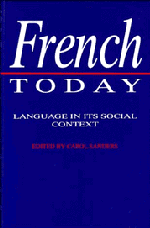Book contents
- Frontmatter
- Contents
- List of figures and maps
- List of tables
- Notes on the contributors
- Acknowledgements
- Introduction
- 1 French: a planned language?
- 2 Sociosituational variation
- 3 Regional variation in France
- 4 The other languages of France: towards a multilingual policy
- 5 The migrant languages of Paris
- 6 Gender and language in French
- 7 The reform of the writing system
- 8 Alternative French
- 9 New words for new technologies
- 10 Language and style in politics
- 11 French and French-based Creoles: the case of the French Caribbean
- 12 French in Africa
- 13 French in Canada
- 14 Sociolinguistic variation and the linguist
- Bibliography
- Index
9 - New words for new technologies
Published online by Cambridge University Press: 05 June 2012
- Frontmatter
- Contents
- List of figures and maps
- List of tables
- Notes on the contributors
- Acknowledgements
- Introduction
- 1 French: a planned language?
- 2 Sociosituational variation
- 3 Regional variation in France
- 4 The other languages of France: towards a multilingual policy
- 5 The migrant languages of Paris
- 6 Gender and language in French
- 7 The reform of the writing system
- 8 Alternative French
- 9 New words for new technologies
- 10 Language and style in politics
- 11 French and French-based Creoles: the case of the French Caribbean
- 12 French in Africa
- 13 French in Canada
- 14 Sociolinguistic variation and the linguist
- Bibliography
- Index
Summary
If we grant that the vocabularies of different languages are not nomenclatures in the Saussurean sense (Saussure 1916 I: 1.1) in a one-to-one correspondence with each other, if we accept that French distinguishes un plan and une carte where English only sees ‘maps’, or un horaire and un emploi du temps for what English calls ‘timetables’, then we might perhaps expect it to go without saying that the vocabulary of a language contains, if looked at from the right angle, a portrait of the culture that uses it.
After all, if we are to talk about objects and actions that are important to us, we need labels for them, and although we should beware of drawing raw conclusions – that English has no ready and generally acceptable translation for the French verb jouir in its most common sense (the last in Harrap, the first in Petit Robert) gives no grounds for supposing Saxon insufficiency in the domain, though the French might like to think so – the basic principle seems firm enough, and it has in fact been said repeatedly from Diderot, ‘la langue d'un peuple donne son vocabulaire, et le vocabulaire est une table assez fidèle de toutes les connoissances de ce peuple: sur la seule comparaison du vocabulaire d'une nation en differens tems, on se formeroit une idée de ses progrès’ (in the Encyclopédie, under the heading ‘langue’) to Dauzat (1949: 118), ’c'est l'étude du vocabulaire qui permet de saisir le mieux la répercussion des influences sociales sur le langage’, but best of all by Meillet (1938: 145): ‘tout vocabulaire exprime une civilization’.
- Type
- Chapter
- Information
- French TodayLanguage in its Social Context, pp. 171 - 184Publisher: Cambridge University PressPrint publication year: 1993
- 3
- Cited by

